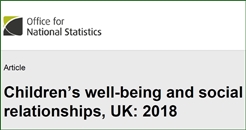 Children’s well-being and social relationships UK: 2018
Children’s well-being and social relationships UK: 2018
From an article by the Office of National Statistics
The Office of National Statistics recently published a 2018 update regarding children's well-being with a focus on relationships. The report series looks into how children aged 0 to 15 years in the UK are coping in a range of areas that matter to their quality of life, reflecting the circumstances of their lives and their own perspectives.
Children’s well-being is an important part of the nation’s well-being. Not only does childhood set the foundation for a well-functioning and healthy adulthood, but children ought to be able to experience life and flourish as individuals.
The quality of family relationships is one of the three most significant aspects of life that contributes to children’s overall sense of well-being. Children with good social relationships with both family and friends were more likely to have higher well-being. Relationships education has become statutory in all schools. The focus is on different types of relationships, how to recognise, understand and build healthy relationships, how relationships may affect health and well-being, including mental health, as well as healthy relationships and safety online.
There is some evidence that social media may have a beneficial association for satisfaction with friendships. However, there was also the recognition of the negative consequences of heavy social media use such as fear of missing out and potential for cyberbullying. Bullying others and being bullied are associated with lower wellbeing and are important factors of children’s social relationships.
This update found that:
-
The proportion of children aged 10 to 15 years who argued more than once a week with their mother fell significantly from 30.5% in 2009 to 2010 to 25.8% in 2015 to 2016.
-
The proportion of children aged 10 to 15 years who talked to their father more than once a week about things that mattered to them increased significantly from 38.0% in 2009 to 2010 to 45.2% in 2015 to 2016.
-
The growth in children talking to their fathers more was driven largely by girls, who reported an increase from 35.7% in 2009 to 2010 to 45.6% in 2015 to 2016, making this aspect of children's relationships with their fathers now very similar for both boys and girls.
-
The proportion of children aged 10 to 15 years reporting high or very high happiness with friends fell significantly from 85.8% in 2015 to 80.5% in 2017, with boys being the main driver of this change.
-
The proportion of children aged 10 to 15 years who reported using social networking sites for more than three hours on a normal school day increased significantly from 8.6% in 2010 to 2011 to 12.8% in 2015 to 2016, with girls more than twice as likely to spend this length of time using social networking sites.
-
Between 2013 to 2014 and 2015 to 2016, there were no changes in the number of children who reported being bullied at school, physically, in other ways or both at least four times in the previous six months. In 2013 to 2014, the proportion of girls and boys who reported being bullied was the same (11.9%). In 2015 to 2016, the percentage of boys who reported being bullied increased to 12.5%, while the percentage of girls who reported being bullied fell to 11.3%. Neither change was significant.
-
Between 2013 to 2014 and 2015 to 2016, the percentage of girls who liked the neighbourhood where they lived increased significantly, from 88.3% to 92.6%.
The shift towards greater social media use could be caused by a range of factors. In particular, the period between 2009 and 2016 has been marked by rapid technological development. Smart phones and tablet devices have become more common, increasing the accessibility of social networking as time has passed. These developments have also affected the ways in which social media is consumed. It is now common to access social media frequently, for a few minutes at a time, using mobile technology.
There are ongoing debates about the extent to which social media use is problematic for young people. In 2017, Emily Frith, based at the Education Policy Institute, reviewed the current evidence and summarised that “social media has many potential positive influences on young people’s lives, such as increasing social connections, helping with homework and enabling teenagers to develop their identities and share creative projects… beneficial impact on wellbeing, and young people recognise the value of opportunities to connect online… [Additionally] Teenagers with mental health problems or concerns are also able to seek support.”
However, there is also research identifying risks associated with social media, including “concerns about excessive time spent online; sharing too much information; being cyber-bullied; the influence of social media on body image; and sourcing of harmful content or advice”.
Download the report from here.
Retweet about this article:
From an article by ONS, 18/04/2018